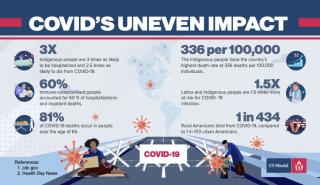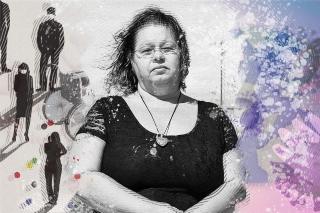On March 12, 2020, the World Health Organization declared COVID-19 a pandemic. After two years, the enormous disproportion of its impact on vulnerable communities has become more apparent.
Imari Kariotis can attest to this reality. She is a multiple disabled woman of color who has autism and bipolar disorder and cares for an adult daughter with several disabilities.
She is a Unitarian Universalist and serves on the board of Disability Rights California and co-chairs the Advisory Council for the Protection and Advocacy for Individuals with Mental Illness Act.
Advertisement
- Can you start by telling us about your personal challenges?
- Sure. I wasn’t diagnosed with my autism until I was 50 years old. I just figured I saw things differently than anybody else.
- After that, I paid more attention to mannerisms I developed, but weren’t natural [to me], like making eye contact a lot because “normal” people do that. I stopped because I thought “they’re going to have to understand me, for me, and they can ask questions. If not, that’s their problem.”
“Autoimmune compromised folks can catch a virus just by someone sneezing in the room without their mouth covered. Just be aware that you’re doing it for your fellow neighbor to take care of your community. So, you’re not burying somebody that you love and care about.”
- My daughter Caurel is nonverbal, so she faced many roadblocks. People didn’t understand why she looked so “normal” but had all these issues. I detest the word normal because it puts everyone in a box. Everyone has a facet, you put them together to make a gem, and the sun shines through it.
- Have adaptations necessitated by the COVID epidemic opened some doors in terms of accessibility?
- Yes. Telehealth enabled more people to talk about their mental illness. Going into clinics, the stigma of people staring at you—it’s rough. So, I am happy this came about, but concerned about people losing the option.
- Also, churches streaming their services opened opportunities to participate for many folks who can’t come to the physical building. Our own church services saw 20 percent to 30 percent more people participate.
- More people joined the annual UU General Assembly (GA) online than in-person for a long time. It’s about accommodation. Even if you just have a stationary camera facing at the pulpit during services, it opens the world to many people with disabilities, to be able to attend church in a way that they feel safe. They feel more like part of the community.
-

The COVID-19 pandemic has disproportionately impacted already vulnerable communities in the United States. We must continue to center their experiences and address their needs when it comes to pandemic-related public health and policy decisions.
© UU World — Designtic 2022 - How do we sustain these measures?
- Being aware. Autoimmune compromised folks can catch a virus just by someone sneezing in the room without their mouth covered. Just be aware that you’re doing it for your fellow neighbor to take care of your community. So, you’re not burying somebody that you love and care about.
- You’re involved with the UU groups EqUUaL Access and DRUUMM (Diverse Revolutionary UU Multicultural Ministries), so could you tell us how well UU congregations are doing at becoming more inclusive?
- There’s a lot more work that needs to be done. Nationally, we could do site surveys for congregations to identify access issues and develop a plan to improve
“DRUUMM is planning regional caucusing and I hope to bring forward a teaching component, to ask questions like ‘Why are disabled people or people of color who visit as guests not coming back?”
- We also need workshops with people of color and white individuals in a congregation to get to know each other better and learn our biases. DRUUMM is planning regional caucusing and I hope to bring forward a teaching component, to ask questions like “You’ve got three people of color in your congregation— why is that?” Why are disabled people or people of color who visit as guests not coming back?
- Personally, I’ve seen people reach out, and go, “Can I help you? What would bring you back to the congregation?” So, I have hope.
- On the other hand, I’m also bisexual. And there are people who will turn their noses up at me for that.
- You work in a sparsely populated area in Southern California and also help deliver food to vulnerable residents. What added challenges do rural people face regarding COVID?
- Our nearest grocery store is 52 miles away. We have a health clinic open one day a week, run by a physician’s assistant. Sometimes you can get in, sometimes you can’t. An ambulance takes 15 to 25 minutes to show up, so many of us have emergency medical training. You have to wear many hats.
- What role do you see your faith and spirituality playing in your work?
-
I’m a nature spiritualist UU, so I roll with the seasons. I’m a big proponent of humanitarian work, both spiritually and in my private life. If I’m out helping someone, that’s like worship for me. It’s my ministry. I feel fulfilled knowing I’ve helped people. And that feeds me, enables me to help more.
